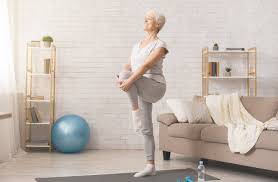As we age, maintaining balance becomes increasingly important for our overall health and well-being. Balance exercises can significantly reduce the risk of falls, which are a leading cause of injury among seniors. Particularly for those who may find themselves more sedentary or have mobility issues, incorporating simple yet effective balance exercises into a daily routine can help improve stability and coordination. In this article, we will explore Top 10 Balance Exercises For Seniors At Home that can be easily performed in the comfort of your own living space. These exercises are designed to enhance strength, build confidence, and ensure that you maintain your independence as you age gracefully.
Understanding Balance and Its Importance
Balance is not merely about standing still; it's an intricate interaction between various systems within our body, including the brain, sensory organs, and musculoskeletal systems. The loss of balance can lead to serious consequences, including falls that may result in fractures or other injuries.
The Mechanisms of Balance
Balance relies on a complex interplay of various bodily systems, primarily the vestibular system (located in the inner ear), visual input (what we see), and proprioception (body awareness). When any of these systems falter, it can lead to instability and increased fall risk.
Vestibular System
The vestibular system plays a crucial role in detecting changes in head position and movement. It helps coordinate eye movements with head movements, allowing us to maintain our gaze and balance while moving. This system can become less efficient with age, making balance exercises vital for seniors.
Visual Input
Our eyes provide essential information about our environment and assist in orientation. As we age, vision may decline, impacting how effectively we can gauge our surroundings. Exercises that focus on improving visual acuity can directly contribute to better balance.
Proprioception
Proprioception refers to our ability to sense the position and movement of our body parts. As we grow older, proprioceptive feedback diminishes, making it difficult to maintain stability. Exercises targeting proprioception can help improve one's ability to control their body's position in space.
Benefits of Balance Exercises for Seniors
Engaging in balance exercises offers numerous benefits beyond just reducing fall risk. Here are some notable advantages:
Improved Mobility: Regular practice of balance exercises enhances overall mobility, making daily activities easier and safer.
Enhanced Strength: Many balance exercises also incorporate strength training, which is vital for maintaining muscle mass and bone density in seniors.
Increased Confidence: Gaining better control over one's body often leads to heightened self-assurance, encouraging seniors to engage in social activities and hobbies they may have avoided due to fear of falling.
Better Coordination: Balance exercises promote improved coordination, enabling seniors to perform multi-tasking activities, such as walking while carrying items.
By understanding the fundamental aspects of balance and its significance, seniors can better appreciate the value of incorporating balance exercises into their routine. Now, let's dive into the specific exercises that can be performed at home.
Simple Yet Effective Balance Exercises
Creating a balanced exercise routine does not require extensive equipment or special skills. Below are ten remarkable balance exercises that anyone can perform at home, regardless of fitness level.
Single-Leg Stand
Beginning with a classic, the single-leg stand is an excellent way to build foundational balance strength.
How to Perform It
Start by standing tall with your feet hip-width apart. Shift your weight onto one leg and lift the other leg slightly off the ground. Hold this position for as long as possible without losing your balance. Repeat on the opposite side.
Benefits of Single-Leg Stand
This exercise not only improves balance but also strengthens the ankle and knee joints. Additionally, it engages core muscles, contributing to overall stability.
Tips for Success
To increase difficulty, try closing your eyes or holding onto a sturdy chair until you feel more confident. Gradually work towards performing the exercise without support.
Heel-To-Toe Walk
Another practical exercise is the heel-to-toe walk, which mimics the act of walking on a tightrope.
How to Perform It
To commence, find a clear, straight path. Place your heel of one foot directly in front of your toes of the opposite foot each time you step forward. Focus on keeping your balance as you continue walking in a straight line.
Benefits of Heel-To-Toe Walk
This exercise enhances coordination and helps train your brain to adjust to center gravity shifts, critical for preventing falls.
Tips for Success
Use a wall or chair for support if necessary, and gradually challenge yourself to complete longer distances without assistance.
Tai Chi
Tai Chi is a gentle, flowing martial art that has been shown to improve balance, flexibility, and strength.
How to Perform It
While Tai Chi classes can be beneficial, there are many online resources available to guide you through basic movements. Start with slow, deliberate motions, focusing on your breathing and posture as you shift your weight from one leg to another.
Benefits of Tai Chi
Not only does Tai Chi improve balance and body awareness, it also promotes relaxation and mindfulness, creating a holistic approach to physical and mental wellness.
Tips for Success
Consider joining a local class or watching instructional videos to learn proper techniques, ensuring you receive maximum benefit from the practice.
Standing March
The standing march is a fun way to mimic walking while engaging your core for added stability.
How to Perform It
Stand tall with your feet shoulder-width apart. March in place by lifting your knees high, swinging your arms in sync. Focus on maintaining an upright posture throughout the movement.
Benefits of Standing March
This exercise builds strength in the legs and core while promoting overall coordination and endurance.
Tips for Success
To make it more challenging, try to close your eyes or march backward, but ensure you have stable objects around for safety.
Side Leg Raises
Incorporating lateral movements enhances hip strength, which is crucial for maintaining balance.
How to Perform It
Stand next to a chair or wall for support. Lift one leg out to the side, keeping your body straight. Hold for a moment before lowering it back down. Repeat on both sides.
Benefits of Side Leg Raises
This exercise targets the abductor muscles in the hips, essential for functional movements such as walking and climbing stairs.
Tips for Success
Try adding light ankle weights to intensify the exercise, progressively challenging your strength and stability.
Chair Stand
The chair stand is a powerful functional exercise that promotes strength and balance, especially when getting up from a seated position.
How to Perform It
Sit on the edge of a sturdy chair with your feet flat on the ground. Lean forward, press through your heels, and stand up without using your hands. Sit back down slowly and repeat the movement.
Benefits of Chair Stand
This exercise strengthens your legs and core while improving functional movements that are essential for daily living.
Tips for Success
As you gain strength, attempt to perform the exercise without supporting yourself on the armrests of the chair.
Back Leg Raises
Targeting the posterior chain, back leg raises help strengthen the lower back and glutes.
How to Perform It
Stand tall, facing a wall or chair for support. Lift one leg straight behind you, keeping it straight and avoiding arching your back. Hold for a moment before lowering it back down. Alternate legs.
Benefits of Back Leg Raises
This exercise aids in building strength in the glutes, which supports good posture and balance.
Tips for Success
To add difficulty, try holding onto weights in your hands as you perform the raises or slowly extending the time you hold each lifted position.
Calf Raises
Calf raises strengthen the muscles in the lower legs, enhancing stability when standing or walking.
How to Perform It
Stand with your feet hip-width apart, holding onto a sturdy surface for support. Slowly rise onto your toes, then lower back down. Repeat several times.
Benefits of Calf Raises
By reinforcing the calf muscles, this exercise helps improve overall balance, particularly when navigating uneven surfaces.
Tips for Success
For an added challenge, try doing calf raises on one leg or on a step to increase the range of motion.
Weight Shifts
The weight shift exercise involves transferring your weight from one leg to another, reinforcing stability and control.
How to Perform It
Begin with your feet shoulder-width apart. Slowly shift your weight to one leg, lifting the opposite foot slightly off the ground. Hold for a moment before shifting to the other side.
Benefits of Weight Shifts
This exercise teaches the body how to manage weight transition, essential for dynamic stability during everyday activities.
Tips for Success
Close your eyes for an extra challenge or perform the exercise on an unstable surface, like a balance pad, to further enhance your skills.
Balance Beam Walk
If you're up for a challenge more closely replicating real-life scenarios, the balance beam walk mimics walking on a narrow surface.
How to Perform It
Use a straight line on the floor or a narrow beam (like a tape line) to walk along, placing one foot directly in front of the other.
Benefits of Balance Beam Walk
This exercise encourages focus and concentration, refining your balance skills while engaging your core and lower body muscles.
Tips for Success
Start with a wider beam or line before progressing to narrower spaces. If needed, hold onto a support object for balance.
Conclusion
Incorporating Top 10 Balance Exercises For Seniors At Home into your daily routine can greatly improve your stability and confidence. Whether you are looking to prevent falls, enhance mobility, or simply enjoy a more active lifestyle, these exercises offer tremendous benefits without requiring much equipment or space. Remember, consistency is vital – practicing balance exercises regularly will yield the best results. Always consult with your healthcare provider before starting any new exercise program, especially if you have existing health concerns. Prioritizing your balance today can lead to a healthier, safer tomorrow.


